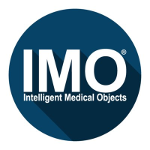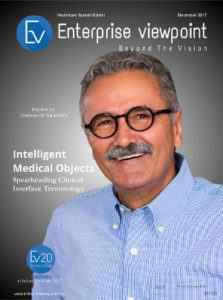Frank Naeymi-Rad, PhD, MBA, Chairman and CEO of Intelligent Medical Objects, Inc was first introduced to the need for standardized medical terminology for decision support while he was teaching medical students at the Chicago Medical School during the 1990s. It was the beginning of the “wild frontier” in informatics—a time when medicine and technology were changing rapidly. He was driven by the idea that it was essential to capture and preserve clinical intent—the “truth” about how and why a specific clinical decision was made. Naeymi-Rad was sure computers would be able to assist clinicians in complex decision-making (artificial intelligence), but that it was crucial for the clinicians to understand how the computer came up with the recommendation. Without transparency, or what is called truth finding, providers would not be able to accept or reject a recommended course of treatment. Trust was essential, and this could only be accomplished if the systems accurately captured information about the patient and the provider’s intent. Standard medical terminology was the foundational technology to allow this to happen.
Today, we refer to such human-machine interactions as machine learning (ML) and artificial intelligence (AI). Fundamental to ML and AI is a trusted standard dictionary for data collection and rules creation. Application of such a standard dictionary in the real world resulted in one of the first electronic medical records (EMRs), developed and commercialized by the IMO team. This EMR was later sold to Glaxo Wellcome, and eventually to a larger EHR vendor, who sells an enhanced version of the product today.
In 2016, IMO received a major investment from Warburg Pincus, an international investment firm with holdings in healthcare and other industries. This partnership between IMO and Warburg Pincus is fueling growth and investment in the company. “Our partnership with Warburg Pincus has accelerated our ability to deliver innovation at the cross section of medicine and computer science,” said Naeymi-Rad. “Without standard terminology; you cannot develop intelligent software objects that can adapt to the ever-changing landscape that we see in healthcare today.”
Today, IMO is recognized as the trusted leader in developing and distributing interface terminology and related services. IMO is built into most of the EMRs and other health information technology covering nearly three quarters of the acute and primary care settings within the US, serving around 600,000 clinicians a day.
Medical terminology brings efficiency and continuity to care
IMO understood from the very beginning that healthcare was ultimately about caring for patients and solving their clinical problems. While billing and reimbursement are necessary, separating clinical documentation from the downstream administrative processes allows providers to focus on what was important—providing care to patients.
Medical terminology is not only vital to healthcare providers but also to patients. As reimbursement codes undergo continual change, many healthcare providers waste valuable time seeking the correct reimbursement code specific to the treatment they are providing. Many codes are not specific enough to fully describe a patient’s diagnoses, causing incomplete clinical narratives and leading to repeated or unnecessary tests, extended communication with administrative staff, lower patient satisfaction, and possible risk to the patient.
Naeymi-Rad describes a couple of examples that illustrate how this can happen. In one case, a woman had been experiencing an irregular heartbeat and had an appointment with a cardiologist. Three years ago, she was diagnosed with breast cancer—specifically “carcinoma of breast, stage 1, estrogen receptor positive.” However, the billing codes associated with this diagnosis translated the detailed clinical condition into simply “carcinoma of the breast.” When the cardiologist looked at her medical record, he sees the previous diagnosis “carcinoma of breast,” but did not see details about staging and estrogen receptor status. He prescribed Cardioquin to treat her arrhythmia, which will decrease the effectiveness of the Tamoxifen she is taking for estrogen-receptor positive breast cancer.
In another case, an orthopedic surgeon saw a man who was diagnosed with bilateral carpal tunnel syndrome in 2015. When he tried to schedule surgery for the patient, he found that he is unable to do so. The diagnosis of bilateral carpal tunnel syndrome, represented by two ICD codes in 2015, was now represented by a single ICD code and this caused a problem with preauthorization for the surgery. Delaying or rescheduling a surgery causes emotional and physical stress for the patient and disrupts workflow for the clinician.
In each of these scenarios, important data was lost—in one case putting the patient at risk and in the other, adding to the workload for the physician. In both cases, data was lost or changed because clinical vocabularies and mappings to standard code sets were not maintained across the various settings critical to the patient’s care. When the information system, now called an Electronic Health Record (EHR) transferred the data to another EHR, only the preferred billing codes were included. In the case of the oncology patient, missing data could impact the effectiveness of the patient’s therapy plan. When the orthopedic surgeon tried to schedule surgery, he was unable to do so because the ICD codes were obsolete, affecting his workflow.
Both cases illustrate the need to have comprehensive clinical dictionaries and codes that are maintained and up-to-date in the ever-changing world of healthcare. “We need to be able to follow the patient through all phases of care,” emphasises Naeymi-Rad. “We need to be sure that the narrative captured in the first patient visit is accurately communicated down the line to all stakeholders along the continuum of care. And we need to be sure that clinical intent is captured and preserved, and not changed as a result of changes in clinical codes,” he underscores.
A unique lexical platform for healthcare interoperability
IMO’s patented, concept-oriented terminology management system and service allows care providers to map different sets of administrative and reference terminologies to the same clinical concept. “We saw that the traditional coding market was ripe for disruption,” says Naeymi-Rad, “and we developed a system and service that today has over 800,000 clinical concepts and millions of different display terms, all mapped to over 100 code systems.” This patented approach of focusing on clinical concepts, which are stable over time, while managing the changing relationships to codes and other concepts driven by regulatory changes and gains in medical knowledge, places IMO at the foundation of successful health information ecosystems.
IMO maintains both concept-to-code and concept-to-concept relationships in a proprietary database that is provided in context-specific services within multiple points in the health information ecosystem. Once clinical intent is documented within the information system using IMO’s Clinical Interface Terminology (CIT), the multiple mapping relationships can be used to ensure that proper coding is available to drive reimbursement, clinical decision support, cohort generation and population health. In addition, links between problems and procedures, including labs and medications, can drive other workflows like automatic summarization of patient status, problem list management/reconciliation and advanced analytics.
The IMO platform paves the way for what Naeymi-Rad calls “the Semantic Highway” for multiple healthcare applications, ensuring that exactly the right information is available for the right patient at the right time, regardless of use case.
IMO believes that standard clinical terminology is a driving force for healthcare interoperability. But without a highly-relevant, clinically-specific terminology, any attempt at interoperability falls short of providing a granular patient narrative. “We understand how critical this mapping is,” says Naeymi-Rad, “and spend significant time and resources to ensure that map between the clinical term and the codes is relevant to current reimbursement regulations and able to change with any future changes that are required, future-proofing the patient, provider and health care facility.” IMO chooses to map each IMO term directly to codes by creating a unique ID, which maps directly to the appropriate reimbursement code set. This curation process ensures that the core term is preserved when future reference codes and reimbursement codes are released, allowing IMO to integrate the new code systems without having to reprogram multiple levels of its platform.
Solutions that put customers first
While IMO already holds 11 registered US patents in addition to numerous US and international patent applications, innovation driven by meeting customer needs remains a cornerstone of the company.
“We believe that close customer interaction leads to high quality solutions,” says Naeymi-Rad. “One hundred percent of our lexical terms come from customer feedback, so IMO is committed to maintaining open lines of communication with all of our customers to ensure greater granularity in describing what is occurring with a patient over time.” Customers provide feedback through face-to- face meetings, calling IMO during business hours, meetings at professional conferences and user group meetings, attending webinars, and through actual products.
Problem IT® terminology is IMO’s flagship product. This industry-leading physician workflow tool captures clinical intent at the point care while offering best-of-breed mappings to code standards. The tool helps to preserve true clinical intent by ensuring that the terms selected are relevant and granular. It helps clinicians create more relevant billing codes, and supplies information required by Federal EHR Incentive Program Stage 3 (Meaningful Use Stage 3), ONC Certification Criteria, and accountable care organizations.
Procedure IT® terminology, another core product from IMO, allows healthcare providers to search and identify specific procedure terms for documentation purposes. Procedure terms are mapped to provide the relevant billing code and information necessary for Meaningful Use. The solution helps create a more detailed narrative of patient’s overall health narrative and ensures accurate mapping of procedure terms as treatment progresses.
IMO also offers PeriOp IT® terminology, which solves surgical procedure scheduling deficiencies by eliminating “inpatient only” coding errors, saving millions of dollars.
The success of IMO solutions can be directly traced to IMO’s awareness of customer needs and commitment to being a trusted partner in delivering quality healthcare. Today, IMO is the most widely-accepted medical terminology solution for the management of medical vocabularies and software applications at healthcare organizations worldwide. IMO’s terminology is used by more than 3,500 hospitals and 600,000 physicians daily.
A future-proof foundation
We are living in a world of escalating change, and nowhere is this more apparent than in healthcare. New discoveries and vast amounts of clinical data collected every day give greater insight to patients, providers, and policymakers, changing the way we work and see the world. Managing this change at the point of service and throughout the healthcare enterprise requires the ability to both manage the complexity of the process and understand the context for each use case.
“Where today we rely on the clinician to make decisions, tomorrow’s decisions may be influenced more and more by artificial intelligence and expert systems,” says Naeymi-Rad. “However, these systems are only as good as their underlying knowledge and coding systems. This is why the codified data and rules that serve as the foundation for this knowledge are so critical. If we are to manage the complexity of healthcare, we need transformative technology that can adapt to a rapidly changing world.”
IMO 2.0, the company’s latest innovation, is an enterprise terminology platform for change management at the application level, data level, and point of care. In a logical layered application design, all layers need to communicate with one another, working together in a supportive infrastructure. “So many applications in the EHR become obsolete almost immediately because the underlying terminology changes,” explains Naeymi-Rad. “Coding changes should not change the patient’s history—mapping should be managed in the background.”
The 2.0 platform keeps all medical records, AI, and expert systems continuously updated with regulatory, policy, and coding changes. It works as a bridging mechanism between machine communications and reporting requirements and brings just-in-time change management to the entire enterprise.
IMO 2.0 clinical interface terms have up to 100 reference maps—for example, SNOMED®CT, ICD, or LOINC® — to ensure that all terms are maintained at the highest level of integrity as information moves through the healthcare ecosystem. It is a single solution to streamline operations and overcome quality care and reimbursement challenges.
“IMO is committed to maintaining health information integrity and semantic interoperability far into the future,” concludes Naeymi-Rad. Through a team culture of quality, innovation, creativity, and fun, IMO supports their clients with innovation, transparency in decision support, and accountable care.
© 2018 Intelligent Medical Objects, Inc. IMO and Intelligent Medical Objects are registered trademarks of Intelligent Medical Objects, Inc. All rights reserved.
SNOMED and SNOMED® CT are registered trademarks of the International Health Terminology Standards Development organization.
LOINC is a registered trademark of the Regenstrief Institute, Inc.












